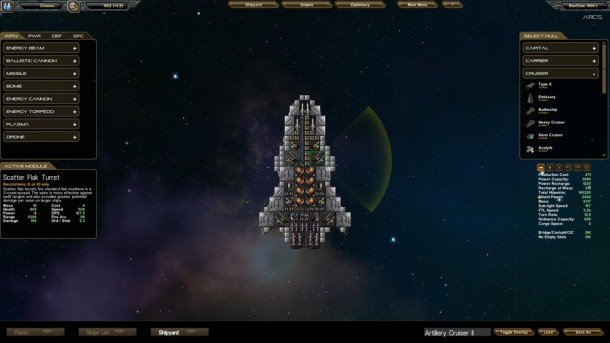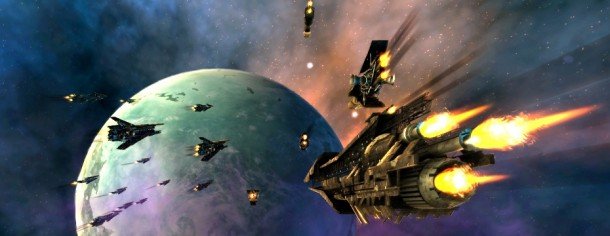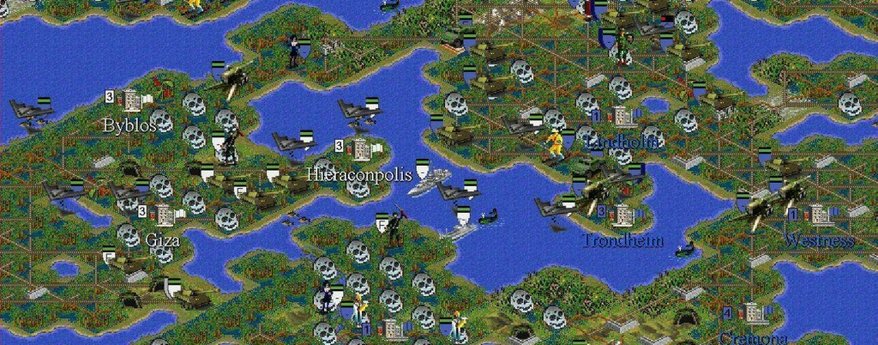Interview: Endless Space and StarDrive developers talk about 4X design
PCG: Have you built any information-gathering technology into Endless Legend?
Romain: No, unfortunately. We're too small for that. I hope, before we start our next game, we'll be able to do that. Each time we say, well, we'll get to that at the end, and then you never have the time. That's the last thing you want to do at the end of the process. Next time we'll make sure to get that done at the beginning and keep tracking as we're doing the game. You have to have a server running and accessible all the time.
One day we did some tracking at Ubisoft, for the multiplayer on Dark Messiah, and we made some mistakes. We tracked every projectile that was coming out, instead of tracking which weapon was being used. It was so much data that we just crashed the server. So that was bad. You really need to have some good technical people to take care of that stuff. But once it's in place… Now we have much better tools for that kind of thing, so it's probably easier to do.
PCG: You've both designed about one and a half 4X games now. When you started working on the first one, what did you look at as far as the other 4X games that have been made when you were thinking, this is what I want to do that's unique?
Romain: The weird thing is, on all the games I love… To go back to something earlier, for historic games I loved Civilization IV, and for space, Master of Orion II. But then I have many others I liked. For each one of them, strangely enough, I remember more about what frustrated me, the frustrations I had in these games, than anything else.
By working on my games, I'm trying to approach those frustrations and see how I can remove them. Can I find mechanics to repair that? How can I make exploration interesting? How can I make the universe more immersive? How can I create a sense of continuity in battles and everything else that happens in the world? I'm not just thinking about game mechanics, but also just reducing the distance between the game and the player, and all the tools we have for that. That goes from the music to the interface to the terrain to the game rules.
The problem that you have as a designer sometimes, you tend to have fun creating new gameplay elements. You add and add and add. It's easier to add something than remove something. In smaller, less mature I would say, 4X games, you tend to see this explosion of options. As a player, you just don't know where to click. You get lost in all those elements.
Keep up to date with the most important stories and the best deals, as picked by the PC Gamer team.
Also, when you're a small company, when you have all these choices, it's very hard to put real meaning behind every one of them. I think the challenge is to be able to reduce your mechanics to a very few ones, and to focus on the things that frustrated me before, the places where I never found satisfaction.

Dan: With StarDrive, I wanted specifically to address ship design. The design of the game sprang up around the concept of modular ship design and having some exciting combat with that. I've made countless mistakes making StarDrive. I was a complete newb when I started.
StarDrive experienced a fair amount of success. We did well. We built a community. I finished it. Now I can approach StarDrive 2 with a much more seasoned viewpoint. My approach to StarDrive 2, basically, I'm looking at my frustrations with StarDrive and trying to address the things I thought were lacking.
Each X in the 4X needs to be important. StarDrive was very heavy on the extermination. Now I'm really focusing on exploration. I want to make sure that when we're exploring this world, there are all kinds of interesting things to see and characters to meet, things like that. Romain and I perhaps had very different points of reference when we started out on our projects. Mine was much more newb-ish. But now I think I have a much better perspective, having been through the gauntlet.
It's cool for me to be able to… Instead of looking at another 4X game and trying to base yourself on that, trying to differentiate yourself, now you're looking at your game. Now I have this template. What am I going to do better or do differently? What worked and what didn't?
Romain: The good thing for you, you don't have to find a common ground with the rest of a team. If you want to do something, you just do it. For me, my first community is my team. Once I pass the test of that first community, I can go on to the real community. Sometimes, you need to negotiate and say, okay, you all hate that, so I'll try to put that aside. But as a designer, you think, I really wish I could do that!
Dan: But you also have the benefit of someone on your team who can say, you know what, that's a really bad idea.
Romain: Yeah. It can go both ways.
Dan: Sometimes I don't make that discovery until much later in the process.
PCG: When Endless Space came out… Has it been a full two years? A year and a half?
Romain: It's about two years, yeah.

PCG: I would have said at the time, that 4X wasn't necessarily a dying genre, but maybe it was a sparsely populated genre. I feel like that's really changed in the past two years. Why do you think that is?
Romain: This may sound overly confident, but I would love to say that we contributed to that. I think, strangely enough… We're expecting, as I said, 60,000 people to play our games. We don't expect any more. But we knew, from the numbers that we had on previous games, that something like Civilization had more than two million players. We knew that the 4X genre always had the potential to reach a pretty big niche. You just need to make a game that can attract more people—that's more open, with its game design and visions, to a wider crowd.
Dan: When I got into doing StarDrive, I had a whole other life going on. It had nothing to do with video games. I chose the 4X genre because I thought it was underserved. I saw Civilization, basically, and it was the only show in town. There hadn't been another big one for the better part of 10 years. Galactic Civilizations 2 and Civilization IV. I knew I wanted it, so I built one, and Romain built one. We figured, if we built it, they would come, and they did. Now there's some more interest.
Romain: When you create a quality 4X, as I think we did, you create more interest in the genre. I think there was less interest in the genre because you only had Civilization coming every three years. Besides that, what else did you have? You didn't have much in terms of quality in the 4X genre.
I think the genre was only dying for lack of quality products in that area. Not for lack of interest from players. Again, whenever a Civilization comes out, you have lots of people buying it. I think there was a lot of immaturity in the way 4Xes were made up to that point. People could satisfy themselves with reaching just a few players, keep it cheap, follow the same recipe.
Dan: I think the rise of the indies contributed to this as well. I'm a perfect example. The ability for someone like me to build a team cost-effectively, using the internet and using powerful tools that are cheap… And then I can bring the game to market without paying tons of overhead costs to put it in a box. That's helped bring a lot of these old genres back to life. You have the new XCOM and things like that.
PCG: What do you think, technology-wise, has contributed to that? I don't know how many people made Civ or Civ II, but if you look back at 4X games made in the '90s, it seems unthinkable that one guy, with a freelance artist and a freelance musician, could make a 4X game. Maybe I'm wrong?
Romain: If you go back to the '80s, there were really small teams.
Dan: That's what Sid Meier did, when he made Civilization. It was a pretty small team. Today, we can squeeze so much more power out of a computer using these tools. Today, on StarDrive, I've built it using Unity. Romain also uses Unity for all of his projects.

PCG: All the Endless games use Unity?
Romain: Yeah. I think we both had more or less the same analysis of the market when we started. On our side, we had Unity. It's cheap and powerful technology. We can now have access directly to our distribution channels, which wasn't the case a few years ago. I need fewer players to make my game profitable. Again, the genre that we loved wasn't very crowded.
Dan: The access to Steam is the biggest. Things may be changing with Steam. There are rumors in the pipeline – I went to the Dev Days conference – that basically they're going to make it a self-publishing type of platform. I can't speak for them, but indications are that it's going to be a very different marketplace in a short period of time.
PCG: They want to get away from Greenlight. They want to advance past Greenlight.
Dan: Even so, those relationships… Unless you're on the front page of Steam, or unless you're on sale, you hardly exist. You have to get… You still need to have a quality product to get those banner placements. That was a huge driver of sales for StarDrive, and I'm sure for Endless Space as well.
Romain: If you look at the traditional way of making games… Let's go back, say, seven years ago, just to make sure we're on the right page. A publisher would spend a lot of money on stuff like advertising in printed magazines. They'd do that in every single region. You'd have advertising in stores. You'd make all these boxes. All that comes out of the revenue from the game that would otherwise go to you, the developer. Once everything's come out of it, you get maybe 14 percent, as an average developer. If you're a big star developer it could go up to 30 percent.
How many millions of copies do you need to sell to get enough money back? And that was the whole point. It was extremely difficult for you to make any money, given where the balance point stood between the cost of making the game and the revenue it could bring in. You could only target big markets, ones that were already known for being big. Everyone made a shooter or an RPG, because that was what was selling. You couldn't do something that was aimed at a smaller niche.
Now all that is finished, with digital communities and publishing and everything. That costs practically nothing by comparison. You can make a great game for those 60,000 people and sell it to them all over the world. Steam, I think, reaches 80 countries? It's not the entire world, but it's a pretty big part of the world. We don't have China yet, which is annoying.
Dan: Steam gives you this map of where you've sold all your games. It's fascinating to look at. I saw that somebody bought StarDrive in the Palestinian occupied territories. One copy.
Romain: Yeah, same here. One guy.
Dan: Probably the same guy.
Romain: Maybe he's an American spy. Now we know where to find him.

Wes has been covering games and hardware for more than 10 years, first at tech sites like The Wirecutter and Tested before joining the PC Gamer team in 2014. Wes plays a little bit of everything, but he'll always jump at the chance to cover emulation and Japanese games.
When he's not obsessively optimizing and re-optimizing a tangle of conveyor belts in Satisfactory (it's really becoming a problem), he's probably playing a 20-year-old Final Fantasy or some opaque ASCII roguelike. With a focus on writing and editing features, he seeks out personal stories and in-depth histories from the corners of PC gaming and its niche communities. 50% pizza by volume (deep dish, to be specific).

